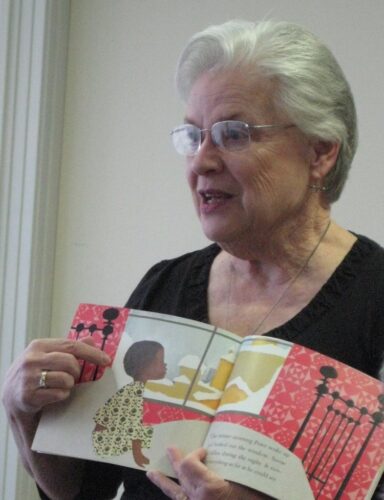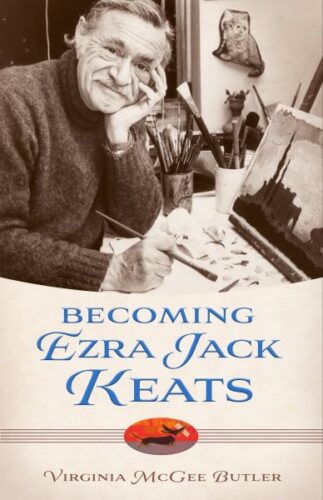Becoming Ezra Jack Keats: Virginia McGee Butler Discusses the Creation of His First Full Biography
How do you write a biography of an iconic creator? Particularly when that biography, remarkably, has never existed before? It seems unbelievable that no one ever thought to sit down and write a full adult biography of the life and times of Ezra Jack Keats, but until this very year of 2023 no one had. No one, that is, until Virginia McGee Butler decided to make one herself. Filled with stories and facts never collected together before, this is the place to go if you ever wanted to hear about, say, a young Eric Carle learning from Keats that you could make a living in picture books. But don’t take my work for it. Becoming Ezra Jack Keats is already out, and I had a chance to speak to Ms. Butler about what went into creating this book:
Betsy Bird: Thank you so much for joining me today, Virginia. And thank you too for doing this deep dive into the life of Ezra Jack Keats. Could you begin by telling us a little about your own personal journey, discovering the works of Mr. Keats. What first drew you to his work?
ADVERTISEMENT
ADVERTISEMENT

Virginia McGee Butler: My introduction to Keats’ work came as I read his books to my children and to my kindergarten and second grade students. We made Snowy Day bulletin boards, complete with our snowflake stamps in Fort Polk, LA and in San Antonio, where most children had never seen snow unless they had grandparents in a more northern state, and in Kaiserslautern, W. Germany, where they might have walked through snow to get to school. After almost thirty rewarding years of teaching, the de Grummond Children’s Literature Collection at the University of Southern Mississippi in Hattiesburg beckoned as I retired to write fulltime.
On my first visit to that collection, a tribute to Ezra Jack Keats with his work and memorabilia filled the display room. Having just received a contest challenge to write for nine-year-olds about someone who had made a difference in the world but was not widely known, I took out my pencil and paper and began making notes. The piece won fourth place with praise for my original sources and was eventually published in Highlights for Children.
As the 50th anniversary of The Snowy Day neared, Viking planned a special edition of the book. Deborah Pope (Ezra Jack Keats Foundation director) and Ellen Ruffin (curator of the de Grummond Collection) designated me to comb through the Keats archives for significant items to include. On a deadline, I had to discipline myself not to linger on items as I made my way through this treasure.
BB: That sounds like a dream directive. You know, many have admired the man’s work but few have taken that next step and written his biography. What was the impetus for creating BECOMING EZRA JACK KEATS?
VMB: Examining the abundance of material during my research for the 50th anniversary edition, I kept wishing I had known his story when I had shared his books with students. The books were so clearly fed by his own experience. Somebody should write about it! By the time I had finished this assignment, I knew I would be back for a more detailed perusal of the archive and an endeavor to write his story.

BB: Speaking of which, this is the first complete biography ever made of the man, a fact that surprised me considerably. How do you account for the fact that no one has ever buckled down and created a Keats bio before?
VMB: I can only speculate about this, but I think there are three factors that needed to be in place for someone to write this biography – (1) an appreciation for Keats work, (2) a passion for writing, and (3) knowledge of and access to the vast repository of his archives at the de Grummond Collection where Keats saved everything – his diaries, letters, and unfinished autobiography drafts; his awards and original paintings; an insignificant lunch receipt; and the back and forth letters to the editor as he defended himself after Nancy Larrick’s “The All White World of Children’s Books” ran in the Saturday Review.
BB: Was there anything you learned about Mr. Keats in the course of your research that surprised you in any way? Any facts the public might not be aware of?
VMB: Surprises were frequent as I researched for the book. Some were fundamental to his life story, such as his childhood in a poverty-stricken, unhappy, immigrant family; his obsession with art from preschool days; and the way that the richness of experience in those early years shows up constantly in his illustrations in children’s books. Almost daily, I discovered small gems inside that story like his bewilderment when Ruth Gagliardo called to tell him he had won the Caldecott medal and he had never heard of it, or his encounter with a young artist named Eric Carle that Keats invited to visit his studio where he offered assurance that Carle could make a living as a children’s book author and illustrator.
BB: Oh, I love that fact! You know, the great K.T. Horning once listed you as an “Ezra Jack Keats” expert. What, to your mind, is the enduring legacy of the man and why does his work still resonate today?
VMB: Keats said that picture books should tell about a “happening” in a child’s life. The happenings that he portrayed are universal and timeless — pets, bullies, snow. They still resonate with children today. That is one legacy. A second legacy has come from the foundation that he founded before his death with instructions that future royalties from his books should be used to do social good. The foundation has promoted diversity with many opportunities for children, especially through public schools and libraries that were so important in Keats’ own life. Additionally, the New Writer and New Author Awards given annually encourage that same diversity in those just beginning their careers.

BB: What in particular would you like people to take away from this book? What do you hope it does?
ADVERTISEMENT
ADVERTISEMENT
VMB: My overall goal from the beginning has been that adults who read this book will find a renewed interest in the timeless books that Keats wrote with an added understanding of how his own childhood fed his creations. I would like for them to make associations between that childhood and the stories that he both tells and shows in his books and to share those connections with today’s children. As an example, one spread in Pet Show pictures an array of kids of multiple sizes, with various hair styles, and diverse skin colors bringing an amusing assortment of pets for judging. He portrays himself as a judge and later includes an elderly woman. In this one book, his paintings convey a message of joyful diversity that he found in the multicultural neighborhood of his childhood.
For individual readers, I hope it resonates with others who have a story similar to Larrie King, one of my former junior high students in Louisiana. His background of marginalized poverty as he sat listening and drawing pictures in the back of my class mirrored the image Keats gave of himself as a student. He made the following comment on my blog when he learned of Becoming Ezra Jack Keats:
Keats was SO formative for me. I remember The Snowy Day from as early as kindergarten and how his incredible illustrations (of a BLACK little boy – just like me!?) impacted me. I was determined to live in the snow (and eventually did!) all because of him. And now as an adult and as a design and illustration professor, his works continue to impact and motivate me and my students.
Ultimately, I would like this book to add to and support the momentum for diverse books that serve as both windows and mirrors for all children.
BB: Finally, what else do you have coming up next?
VMB: As I finished the work on this major project, I have been able to pull some other work off the back burner. I have a short story, “That You, Beulah Rose?” coming out in the Autumn 2023 edition of Thema Literary Magazine. My middle grade historical fiction novel set in 1946 when the shadow of World War II meets the foreshadow of the Civil Rights Movement is out for submission. I am also finalizing a fictional picture book featuring a curmudgeon gopher tortoise, an endangered species in our longleaf forest area, whose neighbors keep taking up residence in his carefully constructed burrow.
I’d like to thank Virginia for taking the time to answer my questions today, and also Courtney McCreary of University Press of Mississippi who helped to set us up in the first place. Becoming Ezra Jack Keats is, as I say, available for purchase now. Take a moment, if you like, and get to know him better.
Filed under: Interviews
About Betsy Bird
Betsy Bird is currently the Collection Development Manager of the Evanston Public Library system and a former Materials Specialist for New York Public Library. She has served on Newbery, written for Horn Book, and has done other lovely little things that she'd love to tell you about but that she's sure you'd find more interesting to hear of in person. Her opinions are her own and do not reflect those of EPL, SLJ, or any of the other acronyms you might be able to name. Follow her on Twitter: @fuseeight.
ADVERTISEMENT
ADVERTISEMENT
SLJ Blog Network
One Star Review, Guess Who? (#202)
Exclusive: Giant Magical Otters Invade New Hex Vet Graphic Novel | News
Parsing Religion in Public Schools
Take Five: LGBTQIA+ Middle Grade Novels
ADVERTISEMENT








I am excited to read this new biography. At the risk of sounding parochial, I would like to mention that Keats’s (born Katz) Jewish background was a formative element in his work; it remains surprising to me how often writers honoring him decline to mention this explicitly. Ms. Butler alludes to his “unhappy immigrant” childhood, and I’m sure that the book itself goes into greater detail about this part of his life. His Jewish immigrant parents no doubt had complex reasons for their unhappiness, but antisemitism was surely one of them. His “multicultural” neighborhood was one of the most Jewish in New York City during his childhood. (After WWII, many more people from diverse backgrounds moved there.) Andrea Davis Pinkney’s wonderful picture book about him directly describes Keats’s Jewish identity. I hope that readers of this new biography gain insights into the role Keats’s Jewish heritage played in both his art and his social activism.
Wonderful interview. I’m looking forward to reading the book.
Thank you, Betsy, for telling us about this new book. I just ordered a copy. And thank you, Emily, for reminding readers of Keats’s Jewish identity.
My teaching career began in 1967 and I taught mostly black kindergarten and grade three children in Title 1 schools in St. Louis, Missouri for 34 years. Ezra Jack Keats books were favorites with me and my students. I hope they are still shared every day in classrooms all over the country. I think of the changes in America since the publication of The Snowy Day with a mixture of sadness and hope. In many ways I believe we have made progress in understanding but I am terrified about the current trends regarding book banning.
I’m eager to read this book. I knew Ezra, who dedicated his book “Goggles” to me.